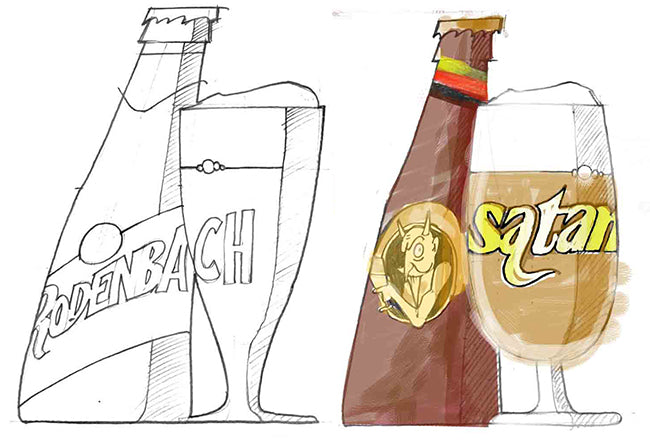Belgium is the home of epic one day racing, from the spring classics to cyclo-cross and the fans and their beer drinking antics make the races unique. If you want to immerse yourself in Belgium cycle culture then start with its unrivalled ales.

Whether it's the dark, strong "tripel" beers brewed by monks in one of the country's six trappist breweries or light, drinkable ales like De Koninck and Leffe, Belgians take their brews every bit as seriously as the French do their wine.
"Strong beer isn't considered something to be scared of", says Maris Flacon of the Dovetail pub, a specialist beer pub in Clerkenwell. "There isn't really a 'craft beer scene' to follow in Belgium, it's more just a part of their culture to enjoy, appreciate and drink great ales regularly."
Trappist

Beer brewed by Cistercian monks. There are only seven Trappist breweries in the world and six are in Belgium. Most Trappist breweries are not open to the public, and the recipes are shrouded in mystery. They are widely considered the epitome of the Belgian beer experience. Rich, thick and full of bite. Trappist beers are complex in flavour and strength.
An electric amber colour, puffing with a yeasty head and strong smell after pouring. Sharp taste with a sour twist at the end. Readily available in supermarkets.
A beer to sup on a cold winter's night. It is thick, rich in taste, and one of the strongest around.
Thick and venomous mythic beer with overriding aroma of liquorice, malty fruit and Christmas pudding. Voted Best Beer in the World, 2005.
Witbiers

Known as bière blanche in France and White Beer in English, these thirst quenching beers are typically cloudy, and are spiced with orange peel and cardamom or coriander and drunk ice-cold with a twist of lemon on summer afternoons. Witbier recipes have been around for four hundred years with breweries reviving the style about fifty years ago since growing in popularity worldwide.
Hoegaarden 8.5%
Reinvented by a milkman in 1966, Hoegaarden is probably the most famous Witbier after it was purchased by a global brewery and made affordable worldwide.
Brugs Witbier 4.5%
A typical example of a modern day wheat beer; cloudy, tart (even without a lemon) and full of citrus flavours.
St. Bernardus Wit 5.5%
A robust beer with extra colour and fizz. Crisp and sharp, it will challenge your taste buds. If you're not a fan of Hoegaarden try this instead.
Blonde/Golden Beers

In medieval times, beer was healthier than water and more like a type of barley soup – practically a meal in itself. Monks began to produce beer in their Abbeys as a source of revenue to rebuild monasteries ravaged by the French Revolution. Blonde beers are part of the 'Abbey Beer' family, but the monks long since sold their recipes to big brewery chains.
Leffe Blonde 6.6%
Expect a pure golden beer with thin lacy head that sits on a soup of fizzy bubbles. Incredibly popular worldwide, even if it's a bit expensive.
Delerium Tremens 9.0%
Fine example of Belgium's strong, golden ales – elected as the best beer in the world.
Piraat 10.5%
A drink to be savoured and enjoyed slowly. With its yeasty and deep biscuit flavour Piraat doesn't hide its alcohol bite like other beers but provides a 'hit' upon tasting.
Flanders Red Ale

Usually brewed in West Flanders, red ales are aged for a long time in unlined oak barrels with a menagerie of wild yeast to product a red sour ale. The matured beer is then blended with a younger batch to balance the flavour. Described as the most 'wine-like', there is no bitterness from hops but expect tannins.
Rodenbach 5.2%
Lip smacking tartness with distinct balsamic flavour. Sour ale is something everyone should try and if you enjoy it try the Rodenbach Grand Cru.
Satan Red 8.0%
Feels thin when it is poured and creates an instantly fruity and punchy aroma. Satan is a strong beer with a delicious tangy flavour.
Amber, dark and other beers

Strong beers range from classic Abbey style brown beers through to thick flavours similar to porter and stout types. Not all beers fit into neat categories, and not all abbey-style brews are made in an Abbey. A plethora of small-production artisan breweries experiment with curious vegetable additions and historic recipes. Don't forget the Belgian fruit beers which are sometimes like swilling a can of pop, though there are some more complex and well crafted brews available too.
Kwak 8.4% (amber)
If you want to tell the rest of the bar you are a tourist in these parts Kwak's unusual glass will send the message. It's no shrinking violet and packs a punch with its flavour. Slightly sweet malt character, woody flavour, dried fruits and warm caramel profile.
Bruggse Zot Dubbel 7.5% (dark)
A light brown head tops a strong, dark, chocolately flavoured ale and smooth finish. Great before a chunky steak and frites.
Boon Kriek 4% (fruit)
Fruit beers can often be too sugary sweet. If you hate fruit beers this remarkable cherry beer just might change your mind.
Our tip, head out on a winter cross ride and finish up with a Belgian beer to feel extra continental. Cross the channel and see the stars of elite cyclo-cross tackle the Keirstperiode in Belgium.